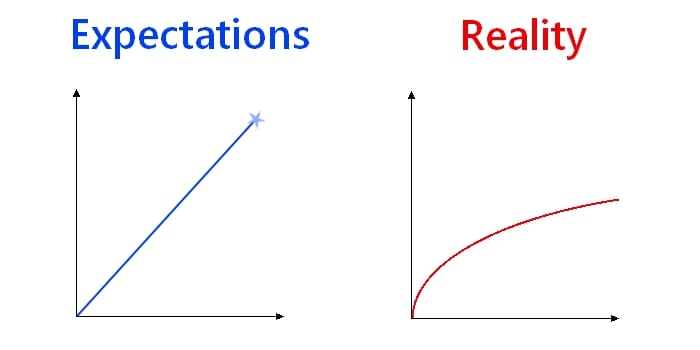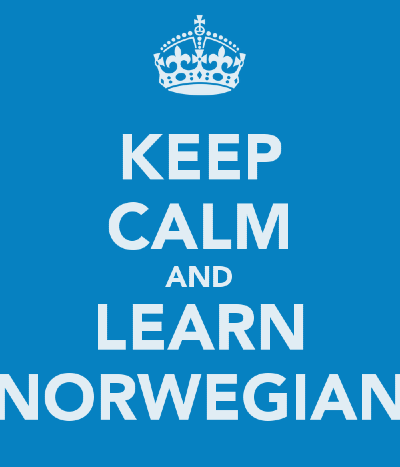Expectations vs. Reality
Struggling with Norwegian? You're not alone. Many learners face disappointment and discouragement, often stemming from unrealistic expectations and misconceptions about the language learning process.

Have you tried one of those learning apps that promise fluency in "x" months/weeks/days and not gotten the result you expected? Have you finished a Norwegian course with the sad realization that you weren't able to communicate in real-life situations? Have you ever been dissatisfied with the slow pace of your progress in Norwegian? If you answered yes to any of these questions, you are not alone. Many learners have experienced disappointment and discouragement.
You may have concluded that you are unable to learn Norwegian because you do not have the talent. This is not a correct explanation. If you were able to learn your native language, you had all the innate abilities needed to learn a new one. The problem is not a lack of talent. You have probably set some expectations that would inevitably lead to disappointment and undermine your learning. Maybe want to become fluent quickly, but language acquisition necessarily takes time. Haste is one of your worst enemies. Understanding how the learning process works will help you calm down, go with the flow, and avoid unnecessary stress.
Unrealistic expectations
It is common to think of progress in language learning as a linear process. People expect to see results whenever they put effort into learning. They hope that they will be able to speak with confidence and without mistakes after completing A1, A2, B2, and C1 courses. Learners with such expectations will be disappointed because language acquisition doesn't work that way. The experience of getting stuck is inevitable. Very often, the effects of language learning are delayed and become visible only after a critical mass of small and invisible improvements has been reached. At certain stages of learning, you just have to keep going and wait for significant results.
If you envision language learning as a steady march from zero to fluency, and you believe that you will get there by simply going through certain courses or self-study materials, you are setting yourself up for failure. This misconception almost always leads to disappointment, discouragement, and self-doubt when you feel your progress slowing down. As a result, many learners lose faith in their ability to master the language to a satisfactory level and give up. In order to stay motivated and avoid unnecessary stress, you need to adjust your expectations to reality.
Easy beginnings
In the beginning, you know nothing. All the words are new. It doesn't take long to get from there to the point where you can at least understand and say something. The first few weeks of learning can be very satisfying. You can quickly learn some basic phrases, such as "Jeg heter...", "Hvordan går det?", "Jeg bor i Oslo", etc. This stage is rewarding because you can immediately see progress.
In every language, there are certain words that occur very often. You encounter them in virtually all texts and hear them in all conversations. I am talking about words like "jeg", "er" or "og". There are other words that don't appear everywhere, but are still very common - for example, "ei jente", "en bok" and "å lage". These so-called "high-frequency words" make up the majority of the words we read and hear. Because of their ubiquity, they are relatively easy to learn.
Every language has about 100 most common words that make up 50% of communication. If you memorize them, you will understand every second word you read or hear. Sounds easy, doesn't it? Unfortunately, knowing the high-frequency words is not enough to communicate effectively in real life. You need a broader vocabulary. Let's look at this example - "En jurist og en stortingsrepresentant snakker om næringsliv". The words "og" (and), "om" (about) and "snakker" (talk) are among the most common. They make up half of our sample sentence. "En jurist" (a lawyer), "en storringsrepresentant" (a member of parliament) and "næringsliv" (business life) are rarer. If you knew only the 100 most frequent words and read this sentence, you wouldn't understand it at all. You would only know that someone is talking to someone else about something. You would have no idea who the participants in the conversation are or what the topic of the conversation is. Understanding 50% of the words doesn't necessarily guarantee that you will have a grasp of the meaning of the sentence.
You need a robust vocabulary to understand authentic content and people communicating in real-life situations. Knowing 100, 300, or even 1000 of the most common words is necessary, but not sufficient. The problem is that the less frequent a word is, the harder it is to remember. Repetition is the mother of memory. In order to fully internalize a word, you need to see and hear it a lot of times in different contexts. Only after many repetitions you will be able to automatically recognize its meaning and actively use it in spoken or written communication.
It is easy to get many repetitions of a high-frequency word like "og". You will encounter such words very often during various interactions with the Norwegian language, whether you are studying it consciously or just using it in your daily life. You will find such ubiquitous words in advertisements, text messages, songs, conversations, Norwegian language textbooks, silly phrases on Duolingo, literally everywhere. Once you have mastered the high-frequency words, the days of easy gains are over. Unfortunately, your vocabulary will not be rich enough to speak freely with people or understand authentic content without checking every second word in a dictionary. You may feel like you are banging your head against a brick wall. It's frustrating, but don't worry - your head is harder than you think.
Intermediate plateau
Paradoxically, feeling stuck is often a sign of progress from beginner to intermediate. You have already mastered the easy basics. Now you are struggling with less common and more advanced elements of the language. This stage is often called the intermediate plateau. Progress is slowing down and things are getting harder, but you have not yet gained the competence and confidence to go out and talk comfortably with people.
The intermediate plateau phase is for many people the worst time in their language learning journey because they don't see any results despite a lot of effort. The lack of progress often leads to the conclusion that you have already reached your maximum and further learning is pointless. This is never true. Stagnation is inevitable. You just have to wait for visible results. Negative emotions make it difficult to stay in the course, but they are unavoidable. The only solution to frustration is to keep on learning in the hope that you will eventually reach a satisfactory level.
Breaking the curse
If you live in Norway, you will need to know the language of this country. Giving up is the worst thing you can do. Sooner or later, life will force you to start learning again. Then you will face the same challenges.
Some people get caught in the vicious cycle of starting, getting stuck, giving up, and starting again from scratch after the break. They always stop when they have grasped the basics and stand before the wall of the intermediate plateau. They hope that the same thing will work this time. But it doesn't, so they give up. The next time they start from scratch, and the cycle repeats itself. They are eternal beginners. Do you see yourself in this story? Well, you are not alone.
The way out of this cursed cycle is not complicated. First and foremost, you need to break the curse of believing that you are incapable of mastering Norwegian. You can. Struggles are not proof of your incompetence. They are a natural part of the learning process. If you just accept that you will experience periods of stagnation along the way, everything will be much easier. Adjusting your expectations to reality will save you a lot of disappointment and give you the hope you need to stay motivated in the face of frustration.
Deep unbelief in your inability to learn Norwegian is the lie that perpetuates the vicious cycle of the eternal beginner. Once you get rid of that bullshit, just keep calm and learn Norwegian. If you already know some basics, don't take another beginner's course. In order to get through the intermediate plateau, you have to learn a little differently than in the beginner stage. You need to spend more time with the Norwegian language. In the beginning, 15-30 minutes a day was enough, but now it is not sufficient to make significant progress. You don't necessarily need to set aside more minutes for focused study. Try to incorporate language learning into your daily life. You can do this, for example, by chilling out with Norwegian-language movies or listening to podcasts during your workout. If you don't know where to find interesting material at your level, you can use LingQ or other services that provide content at different language levels. Podcasts in simplified Norwegian, such as Lær norsk nå, can be very helpful at this stage.
There are better and worse tools you can use, but success in language learning is not about finding the best method and resources. The most important thing is persistence. If your progress isn't what you expected, just be patient. Language acquisition necessarily takes time, and the pace will vary depending on your stage. Don't get discouraged, reevaluate your learning strategy, and stay on track toward fluency.


